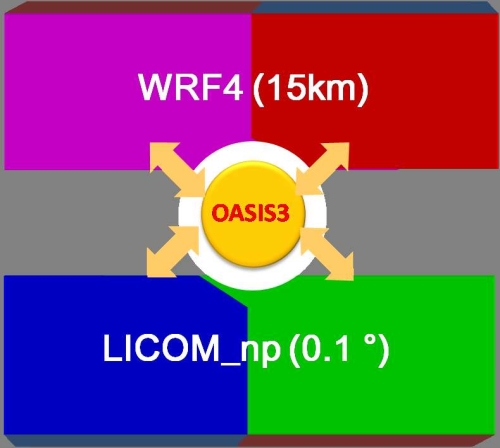
Regional climate models (RCMs) with high-resolution topography and surface characteristics have been widely used for applications from process studies to paleoclimate and climate change simulations.
Regional earth system modeling or regional coupled modeling is one of the frontiers of regional climate modeling, and coupling of the ocean component in RCMs is an important step towards the development of regional earth system models.
Dr. ZOU Liwei from the Institute of Atmospheric Physics (IAP) of the Chinese Academy of Sciences and his collaborators from Nanjing University introduced their recently developed regional ocean-atmosphere coupled model in Advances of Atmospheric Sciences.
"We coupled the recently released WRF4.0 model with a North Pacific Ocean model (LICOM_np) developed at the Institute of Atmospheric Physics through the OASIS3.0 coupler. The horizontal resolution was set to 15 km in WRF4.0, while it was 0.1° in LICOM_np," said Dr. ZOU.
The performance of the regional coupled model, WRF4_LICOM, was compared to that of another regional coupled model, RegCM4_LICOM, which was a coupling between the Regional Climate Model, version 4 (RegCM4), and LICOM_np. The comparison was focused on the 2005 western North Pacific (WNP) summer monsoon rainfall. The results showed that the developed model, WRF4-LICOM, exhibited reasonable performance over the WNP.
In the study, the researchers reported that RegCM4_LICOM exhibited smaller biases in its simulation of the averaged June-July-August sea surface temperature (SST) and rainfall, while WRF4_LICOM better captured the TC (tropical cyclone) intensity, the contribution percentages of rainfall induced by TCs to the total rainfall, and the diurnal cycle of rainfall and stratiform percentages, especially over the land area.
The different behaviors in rainfall simulated by the two models were partly ascribed to the behaviors in the simulated western North Pacific subtropical high (WNPSH).

Model framework (Image by ZOU Liwei)
The researchers speculated that the stronger (weaker) WNPSH in WRF4_LICOM (RegCM4_LICOM) was driven by the overestimated (underestimated) diabatic heating, which peaked at approximately 450 hPa over the region around the Philippines, associated with different condensation-radiation processes.
"Coupling WRF4 with LIOCM is a crucial step towards the development of the next generation of regional earth system model at the Chinese Academy of Sciences," said Dr. ZOU, "and our intercomparison provides a useful reference for tuning the upcoming regional earth system model in the future."
Furthermore, the overall reasonable performance of WRF4_LICOM indicates that these models can be used for a wide range of applications, such as dynamical downscaling of simulations and projections generated by global models.

86-10-68597521 (day)
86-10-68597289 (night)

52 Sanlihe Rd., Xicheng District,
Beijing, China (100864)

